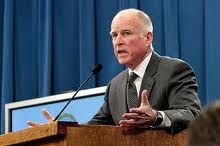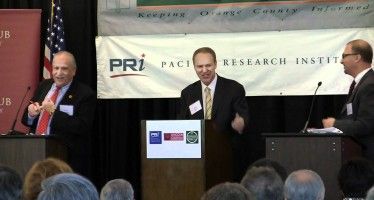May Revise preview
By John Seiler
Tomorrow Gov. Jerry Brown will release the May Revise to his January budget proposal for fiscal year 2013-14, which begins on July 1. These are the base numbers the Legislature will work with as it hashes out a budget before (and maybe after) the June 15 constitutional deadline for passage.
The main surprise is an unexpected extra $4.5 billion in tax revenues. Look for two things: How the budget plans to spend the windfall. Second, what, if anything, will be done with pension reform.
Previous surpluses led to spending profligacy, which in turn brought on deep budget cuts when the economy crashed, bringing down revenues. The most flagrant example was Gov. Gray Davis’ first two budgets, for FY 1999-2000 and 2000-01. Each boosted spending a shocking 15 percent. When the dot-com recession hit in 2000, the deficits of early years returned with a vengeance, forcing cuts.
In 2003, Davis arbitrarily imposed an increase in the car tax. As then-state Sen. Tom McClintock pointed out at the time, the tax increase was unconstitutional because only the Legislature can increase taxes.
The car tax increase was a major factor in Davis’ recall in Oct. 2003. He was replaced by Gov. Arnold Schwarzenegger, who kept a campaign promise to revoke Davis’ car-tax increase. Since then, many Democrats and columnists have insisted that getting rid of this added car tax, saving taxpayers about $3 billion a year, has been a big factor in the state’s fiscal problems. In fact, the Davis car tax really was unconstitutional. If Arnold had not gotten rid of it, McClintock was readying both a constitutional court challenge and, if that failed, a repeal initiative to be put on the June 2004 ballot; it would have passed.
Spendthrift Arnold
But Arnold himself didn’t learn the lesson of Davis’ demise. After holding the line on spending for a couple of years, during the phony economic boom of the mid-2000s, Arnold went on his own spending binge. General-fund spending rose 15 percent in FY 2005-06, then another 10 percent in FY 2006-07.
I remember well the budget battle in 2006-07. The Legislature passed a budget spending $100 billion in the general fund. Arnold responded that there was no way he would be the first governor to sign a budget breaking the $100 billion figure, that spending must be cut. He then submitted a modified budget “under” $100 billion that actually was for $101 billion.
That’s right. He “cut” the budget by adding $1 billion in spending. The Legislature griped about mean old Arnold insisting on “cuts,” then quickly passed the budget increases, which he signed into law.
Thanks to Ian Halperin’s biography, “The Governator,” we now know that, following the defeat of his 2005 Reform Slate of initiatives, Arnold lost interest in his job and basically mailed in his last five years of governing. So he just didn’t care about budgets. Hey, the economy was booming. The sun was shining. Spending too much is a lot more fun than being a skinflint and fighting tooth-and-nail with the Legislature over every taxpayer penny. What could go wrong?
The Great Recession hit in 2007-09, and hit California harder than most other states. Arnold, and successor Gov. Jerry Brown, responded with needed spending cuts but unnecessary tax increases. Even now, despite obviously better times for the California economy, state unemployment was 9.4 percent in March, well above the national rate of 7.6 percent.
Restoring cuts
Despite the halting recovery, Democrats are seeking to “restore” the cuts made during the recession. The Fresno Bee reported:
“Senate President Pro Tem Darrell Steinberg touts restoring Medi-Cal dental benefits and boosting mental health programs as two personal priorities.
“‘There is no shame, in fact there’s pride, in fighting to restore cuts to those who have suffered the most during the budget crisis — the poor, the elderly and the disabled,’ Steinberg said.
“‘But we can only restore programs if there is money,’ he added. ‘And we don’t know whether or not there will be new money.’
“State finance department spokesman H.D. Palmer, representing the Brown administration, said the governor’s basic tenet has been that past cuts must be retained to help pay down debt and ensure future budget stability.
“The notion of a $4.5 billion windfall is illusory because much of it may not be available for more than one year and, besides, the vast majority of it must go to public schools and community colleges under Proposition 98, Palmer said.
“‘I can understand that a lot of people are looking at the current revenue numbers and jumping to the conclusion that that’s money with no strings attached,’ Palmer said. ‘That’s not the case.'”
So, the question is: Will the restored funding rise as high as the profligate, unsustainable levels of 2005-07? Or will the restored funding rise only to the more reasonable, sustainable levels of 2003-04?
Pensions
And of course, a major factor remains what to do with the state’s pension funds. As Dan Walters just reminded us, unfunded pension liabilities run as high as $500 billion; and all unfunded liabilities could be as high as $1 trillion. The pension spiking Gov. Davis signed into law from 1999-01 still is haunting the state. The California State Teachers’ Retirement System just demanded another $4.5 billion a year from the general fund for 40 years to keep its system solvent.
Last September’s pension “reform” was like putting a Band-Aid on a gaping wound. It did accomplish its goal of helping voters push the Yes lever on Proposition 30, the $6 billion tax increase. The money was advertised as going to school children; but now will just go to pensions.
The actuarial realities dictate that one day the Legislature will have to deal with the pension shortfall. It’s unlikely this will be the year. We’ll find out tomorrow.
Related Articles
Is California 'lean'?
MAY 4, 2010 K. LLOYD BILLINGSLEY The May 1-7 issue of The Economist magazine, in a section under California government,
Wyland Bill Targets the 'Bill Factory'
MAR. 29, 2011 By KATY GRIMES The massive production process of the “bill factory” at the Capitol can be considered
Greenhut-Berardino Debate on Pensions
APRIL 27, 2011 By JOHN SEILER It was the Great Pension Debate. Yesterday Steven Greenhut, editor-in-chief of CalWatchDog.com, debated Nick




